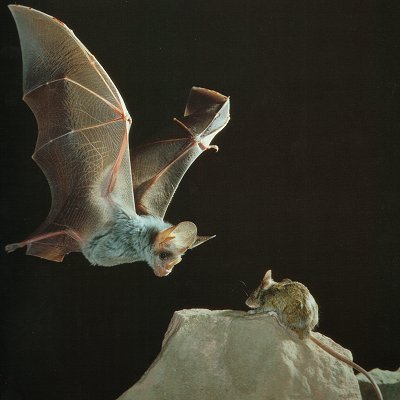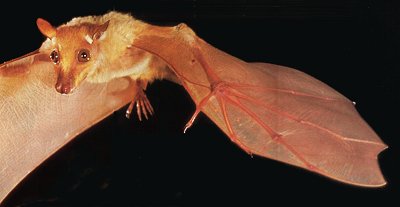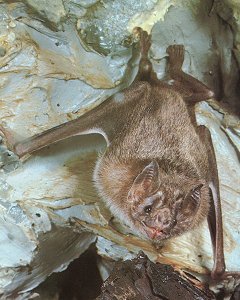THE ORDER CHIROPTERA
Chiroptera – Finger Winged Mammals (About 970 species)
Flight clearly distinguishes bats from all the other mammals. Not just jumping or gliding, but actually being able to fly – like the birds. The entire bone structure of bats is modified for flight, and as we should expect, this is most noticeable in the arms. As the name “Chiroptera” (“hand wing) translates, the wings are formed by a stretched membrane across elongated finger bones to the sides of the body and all the way down enclosing the legs and tail. In the Megachiroptera (large bats), however, the membrane does not extend across the legs down to the feet, as it does in the Microchiroptera (small bats). In the picture above of a Flying Fox (because of the fox-like face) we can clearly see the hand splitting into five fingers, connected with an umbrella-like membrane, with only the top-notch of the thumb sticking out.

The wing membrane is naked, although in some species the body fur may grow somewhat out onto the wing. When the wing is not extended the membrane folds up along countless creases more efficiently than an umbrella.
The world’s only true flying mammals, bats are all gathered into one order, Chiroptera. They probably developed from arboreal insectivores, possibly tree-dwelling animals, 70,000,000 years ago, and possibly as far back as 100,000,000 years.
Their species number almost 1000, second only to the Rodents. Bats are found in every part of the world except the polar regions and far out across the ocean. The order is clearly divisible into two very distinct suborders: the Megachiroptera, consisting of 173 species of flying foxes and other large fruit bats; and the Microchiroptera, which contains all the other smaller, generally insectivorous, bats.
So diverse are the small bats that they have been sorted into 16 separate families, while the fruit bats are all contained in a single-family. The large bats inhabit the tropics and subtropics of Africa and Australia and Asia, while the small bats are found worldwide.

Rather than displaying quick maneuvers, flying foxes have a powerful and steady type of flight. They use their acute vision, even when flying at night. The small bats have a reasonably good eyesight but do not depend upon it in flight. Instead, they have developed a remarkable sense of hearing and guide themselves by echolocation, or sonar. This type of bat constantly emits high-frequency clicking sounds, up to 200 per second, and outside the highest range of human hearing. When the sound waves strike objects in their path an echo is returned to the bat. It can then judge distances between itself an object, such as a stone wall or a tiny insect, and so it literally hears its way around.
Since bats in flight perceive insects in this manner, this accounts for their sudden darting twists, turns, and dives while in pursuit. If bats are indeed evolved from insectivores, then echolocation as a means of finding flying insects in the dark probably developed very early on. Bats eat all types of nocturnal insects, but beetles and moths probably top the list.

Yet some species of small bats have forsaken a diet of insects, and have cultivated other tastes. Like their distant relatives the flying foxes, a few species of Microchiroptera feed on ripe fruit, while others feed on nectar and pollen. This vegetarian diet common to the leaf-nosed bats of the American tropics. And yet, in this same tropical region, at least two species catch and eat fish picked from the water’s surface. And there are carnivorous (indeed cannibal) bats. Two other species in tropical America prey upon birds, rodents, and other bats.
African and Asian false vampires and Australian ghost bats, the largest of the Microchiroptera, likewise devour frogs, birds, and small mammals, including other species of bats. But perhaps the most bizarre feeding habits belong to the true vampire bats. They consist of three separate species in the subfamily Desmodontinse. Vampires feed exclusively on the blood of large mammals and birds and are the only vertebrates (having a backbone) with such a diet. They do not suck blood, as is commonly believed, but bite a neat wound through the skin from which they siphon the blood through a uniquely shaped lower lip – much like a straw. Like the mosquito, the vampire bat’s saliva contains an anticoagulant to keep the blood flowing.
